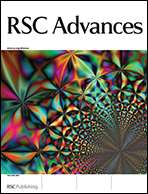Water-induced aggregation and hydrophobic hydration in aqueous solutions of N-methylpiperidine†
Abstract
Liquid system N-methylpiperidine–water shows a miscibility gap with a lower critical solution temperature of 316.7 K. The phase separation is most likely due to the aggregation of N-methylpiperidine–water complexes, evident in the intensity of the small-angle neutron scattering at temperatures much lower than the LCST. Such complexes arise because the attraction forces between unlike molecules are stronger than the water–water ones, and aggregation is possible through the O–H⋯O bonds involving the hydration water molecules. The aggregates are dynamic structures with nanoseconds-order relaxation times, as it was estimated by the ultrasonic absorption experiment. While hydrophilic aggregation prevails at relatively high concentrations of the amine, the hydrophobic hydration is possible at low concentrations, likely consisting of the formation of structures resembling those in the sH clathrates observed in the solid state. The hydrophobic hydration of N-methylpiperidine is manifested in the minima of the partial volume isotherms at the amine mole fraction close to 0.01 and in the limiting partial molar compression approximately equal to zero. Essential similarity of the N-methylpiperidine–water system to aqueous solutions of pyridine and its methyl derivatives studied previously, suggests that those amines are potential clathrate hydrate promoters.


 Please wait while we load your content...
Please wait while we load your content...